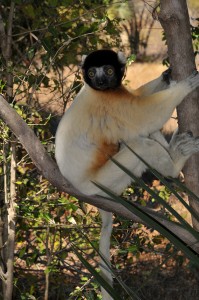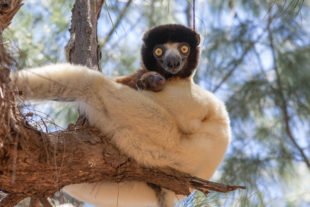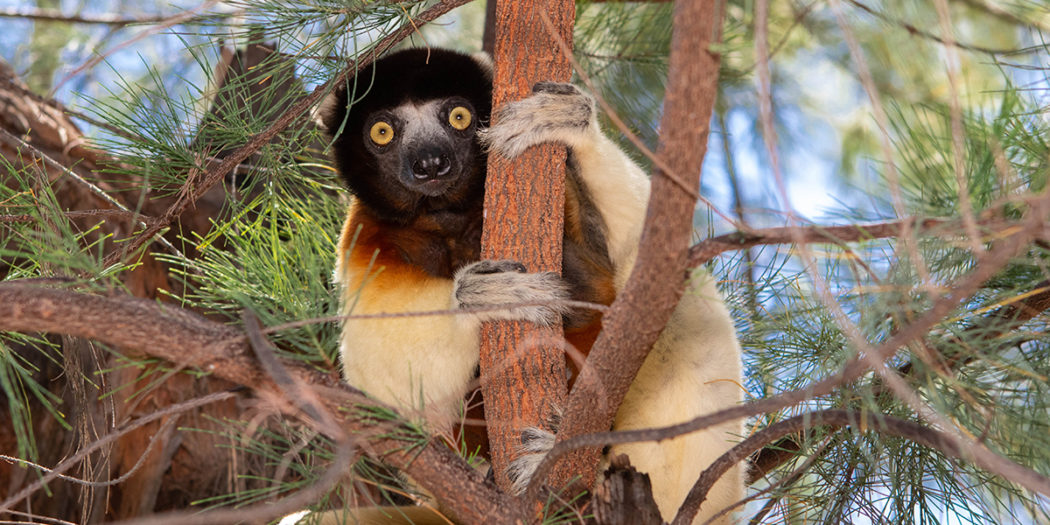In the northwest of Madagascar live lemurs, which occur quite frequently, but are nevertheless hardly researched: The Crowned Sifakas (Propithecus coronatus). Their habitat is limited by the two rivers Mahavavy in the southwest and Betsiboka in the northeast. Today, however, there are indications that the species is much more widespread and also populates areas around Tsiroanomandidy, Amboloando (south of Miandrivazo) and the river Sakay. This means that Crowned Sifakas occur at altitudes of up to 700 m above sea level. The easiest way to observe them is on the Katsepy Peninsula in a small wooded area. The preferred areas of the Crowned Sifakas lie in sandy dry forests, but they can also cope with narrow forest corridors, riparian forests and even mangroves.

Crowned Sifakas are easily recognizable by the chocolate brown or black wreath of fur that surrounds the face, in combination with a cream or white body. The shoulders, thighs, chest and back of mainly male individuals show golden-brown markings, which merge into golden yellow towards the belly. This colouring comes mainly from the chest glands, which are more secreting in males. The faces of both sexes are black or grey, just like the palms and feet. With a body length of about one meter and a body weight of 3.5 to 4.3 kg, Crowned Sifakas are not exactly the heaviest or largest of the lemurs, but they are nevertheless impressive personalities. In the past, the animals were thought to be a subspecies of Verreaux’ or Van der Decken’s Sifakas – they actually look very similar to them.
Crowned Sifakas are social animals that live in small groups of up to eleven animals. The differently composed groups especially like to be in the crowns of thick, large trees and rarely come to the ground. As with almost all lemurs, the females set the tone and play a decisive role in the daily routine. Almost half of the day is spent looking for food, because not all trees offer the right green for the choosy lemurs. Their diet includes leaves, flowers, buds and in the rainy season also fruits. The rest of the time Crowned Sifakas use for extensive mutual coat care, more rarely also with games. As far as we know, they mark their territory borders less often than other species and are not the loudest in communication with calls. The Sifaka-typical and eponymous “Sheee-fak”-call in case of danger is of course also shown by Crowned Sifakas, but seldom used.

They defend their relatively small, 12,000 to 15,000 m² large territories against intruders of the same species, especially when it comes to food resources. Other species occurring in the same areas, such as Red lemurs (Eulemur rufus) or Mongoose lemurs (Eulemur mongoz) are peacefully tolerated. The mating time of the Crowned Sifakas lies between January and March. Only every two or three years the females give birth to one or two young animals, which then stay with their parents for a long time.
In contrast to many other lemurs, the Crowned Sifaka on the IUCN red list were long only listed as “endangered”. In reality, however, it is assumed that the population of Crowned Sifaka has decreased by more than 50% in the last 50 years. There are an estimated 1,000 animals left. Threats are the slash-and-burn of their habitats and the deforestation of the remaining forest for firewood, illegal exports of tropical timber and cattle pastures. Since the species is relatively adaptable, individuals are also caught for illegal trade outside Madagascar. In 2018, the classification on the red list was therefore raised. Crowned Sifaka are now officially threatened with extinction.

On the Katsepy Peninsula, the Antrema Forest Station is working to advance the protection of Crowned Sifakas through research. There is also a European breeding programme for this species with a handful of individuals (less than 20) in various zoos (including Mulhouse and Besançon in France, Cotsworld and Port Lympne in the UK, Apenheul in Holland and Belfast in Ireland). This only works because the animals are less restricted in their choice of food than, for example, Indris, who are not kept in any zoo in the world. Furthermore, efforts are being made to protect other habitats of the Crowned Sifaka. In Crowned Sifakas, early intervention in the increased protection of habitats could be timely enough to maintain stable populations.
 MADAMAGAZINE Your Magazine about Madagascar
MADAMAGAZINE Your Magazine about Madagascar








